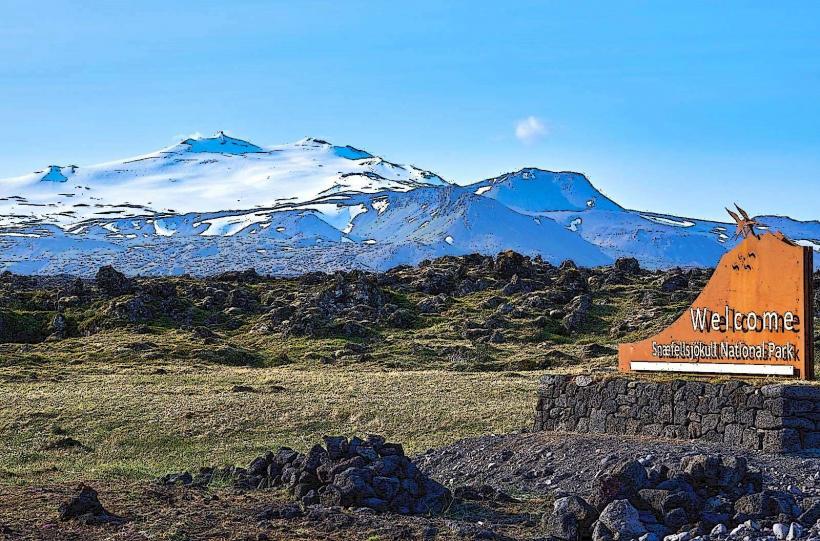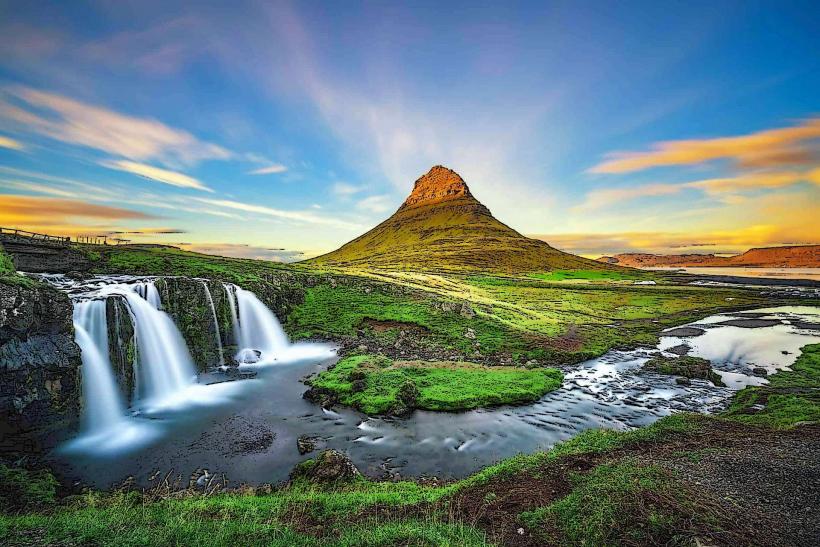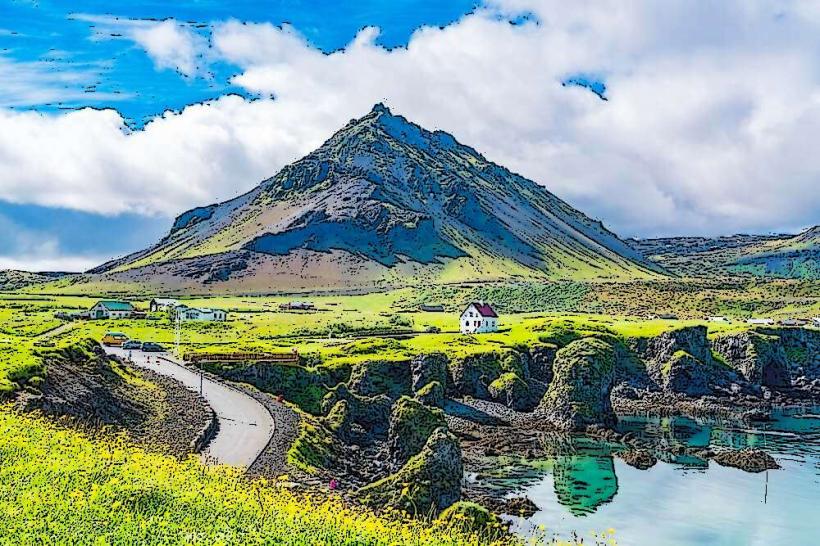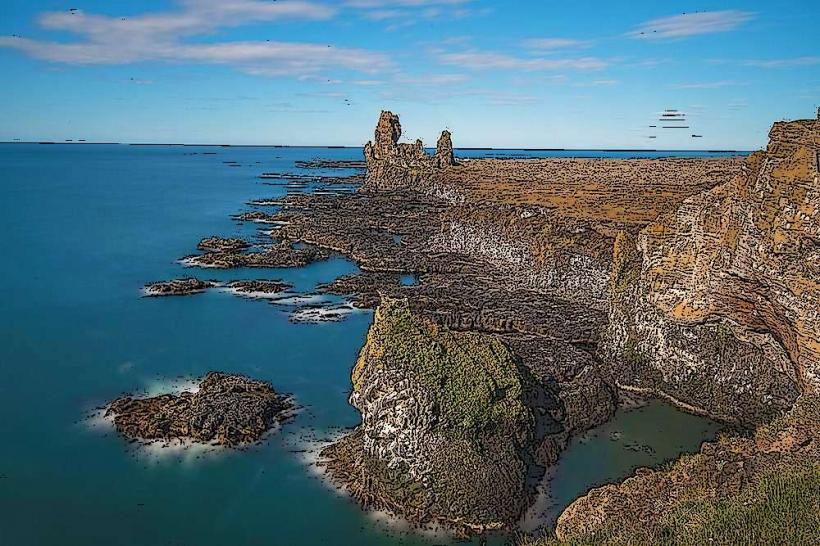Information
City: SnaefellsnesCountry: Iceland
Continent: Europe
Snæfellsnes is a stunning peninsula in western Iceland, often referred to as "Iceland in miniature" due to its diverse landscapes, which encapsulate many of the country’s most iconic features. From dramatic mountains and glaciers to volcanic craters, lava fields, and picturesque coastal villages, Snæfellsnes offers a microcosm of Icelandic nature and culture. Here’s a detailed exploration of Snæfellsnes:
Geography and Natural Setting
- Location: Snæfellsnes is located in western Iceland, extending into the North Atlantic Ocean. It lies between the fjords of Borgarfjörður and Húnaflói and is easily accessible from Reykjavik, about a 2-3 hour drive away.
- Diverse Landscapes: The peninsula features a variety of landscapes, including towering mountains, rolling lava fields, glaciers, volcanic craters, dramatic coastlines, and idyllic beaches.
- Snæfellsjökull Glacier: The most famous feature of the peninsula is the Snæfellsjökull glacier, which sits atop an active volcano. This glacier is central to the area's natural beauty and mythology.
Climate
- Temperatures: Snæfellsnes has a subarctic maritime climate, with mild summers and cold winters. Summer temperatures average around 10-15°C (50-59°F), while winter temperatures range from -1°C to 3°C (30-37°F).
- Weather: The weather in Snæfellsnes is variable, with frequent changes in wind and precipitation. Coastal winds can be strong, especially during the winter months, and the area is known for rapid shifts between sunshine, rain, and snow.
- Seasonal Light: Long summer days bring the midnight sun, while winter brings dark nights perfect for viewing the Northern Lights.
Key Natural Features and Attractions
- Snæfellsjökull National Park: This park is a highlight of Snæfellsnes, surrounding the Snæfellsjökull glacier. The park is home to a variety of hiking trails, lava fields, volcanic craters, and dramatic cliffs. It is also steeped in folklore and was the setting for Jules Verne’s novel Journey to the Center of the Earth.
- Lóndrangar: Two striking volcanic rock pinnacles rise dramatically from the sea, creating a spectacular coastal landmark. Lóndrangar is a popular spot for birdwatching, particularly puffins.
- Arnarstapi: A picturesque village on the southern coast of Snæfellsnes, Arnarstapi is known for its rugged coastline, dramatic cliffs, and rock formations. It’s a great base for exploring the nearby coastal trails and enjoying the stunning sea views.
- Hellnar: A small village with historic significance, Hellnar features beautiful coastal scenery, and visitors can walk between Hellnar and Arnarstapi along a scenic coastal path, passing dramatic cliffs and birdlife.
- Búðakirkja: This iconic black church is located in the small hamlet of Búðir. Set against a backdrop of vast lava fields and with the Snæfellsjökull glacier looming in the distance, it is one of Iceland’s most photographed churches.
- Kirkjufell: One of the most photographed mountains in Iceland, Kirkjufell is a symmetrical peak located near the town of Grundarfjörður. The mountain is often photographed alongside the nearby Kirkjufellsfoss waterfall, creating a stunning and iconic landscape.
- Djúpalónssandur Beach: This black sand beach features unique rock formations and remnants of a shipwreck, adding an eerie yet beautiful touch to the coastal landscape.
Wildlife and Natural Environment
- Birdwatching: Snæfellsnes is a prime location for birdwatching, especially around cliffs like Lóndrangar and Arnarstapi, where you can spot puffins, guillemots, and other seabirds.
- Marine Life: The waters around the peninsula are rich in marine life, and whale watching tours are popular, especially during the summer months. Minke whales, humpback whales, and orcas are often spotted here.
- Flora: The peninsula is home to a mix of coastal vegetation, including wildflowers, moss, and lichen. The lava fields are covered in green moss and offer a striking contrast to the barren volcanic landscapes.
Cultural Heritage and History
- Fishing Communities: Snæfellsnes has a rich history of fishing, with many small villages like Ólafsvík and Grundarfjörður historically depending on the sea for their livelihoods. The region’s coastal culture is still evident in the preserved traditions and local fishing industries.
- Folklore: The peninsula is steeped in Icelandic folklore, particularly surrounding the Snæfellsjökull glacier. It is often associated with tales of mystical creatures, such as elves and hidden people, and was said to be a portal to the center of the Earth, thanks to Jules Verne’s novel.
- Museums and Heritage: Snæfellsnes is home to several small museums, including the Snæfellsnes Heritage Center in Ólafsvík, which showcases the area's cultural and historical significance.
Outdoor Activities
- Hiking: The region offers numerous hiking opportunities, from coastal trails like the one between Arnarstapi and Hellnar to more challenging mountain hikes around Snæfellsjökull. There are trails suitable for all levels of hikers, offering spectacular views of the coastline, glaciers, and mountains.
- Caving: The area’s volcanic terrain includes caves and lava tubes that are ideal for exploration. Visitors can take guided tours into some of these caves to learn about the region’s geological history.
- Fishing and Boating: The coastal waters of Snæfellsnes are great for fishing, and boat tours are available for those looking to explore the fjords and coastline from the sea.
- Horseback Riding: Icelandic horseback riding tours are available, offering a chance to explore the peninsula’s varied landscapes on horseback.
Tourism and Accessibility
- Transportation: Snæfellsnes is easily accessible from Reykjavik by car (about 2-3 hours’ drive). The peninsula is well-connected to the rest of Iceland via Route 54, and visitors can also access the region by bus or organized tours.
- Accommodations: The peninsula offers a range of accommodations, from guesthouses and hotels to camping sites. Many visitors base themselves in the towns of Grundarfjörður, Ólafsvík, and Stykkishólmur.
- Dining: Local seafood is a highlight of the region’s cuisine, and there are several restaurants in the towns that offer fresh, locally sourced dishes.
Atmosphere
- Serenity: Snæfellsnes is known for its tranquil and peaceful atmosphere. With relatively fewer tourists than other parts of Iceland, visitors often find the region to be a quiet retreat, perfect for connecting with nature.
- Mystical Aura: The combination of its natural beauty, folklore, and the towering presence of Snæfellsjökull glacier creates a sense of mysticism and adventure that draws people from around the world.
Snæfellsnes is a microcosm of Iceland's wild beauty, offering diverse landscapes, rich history, and unique experiences. Whether you're an avid hiker, a photographer, or someone simply looking to explore the natural wonders of Iceland, Snæfellsnes is an unforgettable destination.






